
North American Indigenous Games
Regina 2014
Photography project
Tisdale,
Monday, August 18 2014
by Timothy W. Shire
Regina 2014
Photography project
Tisdale,
Monday, August 18 2014
by Timothy W. Shire
.In the summer of 2005 Ken Jones organised about fifty amateur photographers, in Regina’s two camera clubs, to involve them in documenting the 2005 Canada Summer Games held in Regina. I was brought in to catch the production from the photographers each day, sort through the images and post online the best images. The project was a remarkable success as the outstanding work of the photographers became the highlight for many athletes who had come to compete in the games. At the end of the two weeks, I was completely exhausted and after a brief bout of pneumonia gained some perspective on what we had done.
When Ken learned that the North American Indigenous Games were to be held in Regina this summer, he automatically went into high gear to repeat the event, using the system perfected nine years earlier. There were some dramatic differences. The games this time were only seven days long, instead of two full weeks and instead of appealing to the photography clubs, Ken went to those volunteering to work at the games. We were firmly on track and it looked like things would fly until Ken’s father, a 94 year old World War II veteran living in Halifax, entered the last stage of his life. Of course Ken had to go to Halifax and my role shifted from handling the images and the internet, to handling the project.
The lead time was short and two serious factors made things a bit difficult. I was not in Regina, but here in Tisdale and we needed to organise the volunteer photographers. The second factor was that the organising committee had difficulties locking down their schedule of events and then getting that information out.
The volunteer list of photographers was a whopping 182 people. I proceeded to get in touch with them using email and discovered that many had just checked off photography on the list of things they might volunteer for and they were not at all serious about the project. To get through the serious and non serious folks, I asked for them to confirm their participation by sending me their phone number and this resulted in a working confirmed list of 62 people. The next thing was to sort out their equipment and interests so that I could develop a working schedule.
Seemed like a good idea at the time, but the process was flawed because the schedule of events was released only a little more than a week before the games were to begin. This was the time I should have been spending developing the process and web site for the project, but instead I was dealing with the volunteers. To sort out their capabilities, I asked them to fill out an online questionnaire. Again it seemed like a good idea at the time, but, of the 62, less than thirty filled in the form, from which I was to develop a schedule.
When Ken learned that the North American Indigenous Games were to be held in Regina this summer, he automatically went into high gear to repeat the event, using the system perfected nine years earlier. There were some dramatic differences. The games this time were only seven days long, instead of two full weeks and instead of appealing to the photography clubs, Ken went to those volunteering to work at the games. We were firmly on track and it looked like things would fly until Ken’s father, a 94 year old World War II veteran living in Halifax, entered the last stage of his life. Of course Ken had to go to Halifax and my role shifted from handling the images and the internet, to handling the project.
The lead time was short and two serious factors made things a bit difficult. I was not in Regina, but here in Tisdale and we needed to organise the volunteer photographers. The second factor was that the organising committee had difficulties locking down their schedule of events and then getting that information out.
The volunteer list of photographers was a whopping 182 people. I proceeded to get in touch with them using email and discovered that many had just checked off photography on the list of things they might volunteer for and they were not at all serious about the project. To get through the serious and non serious folks, I asked for them to confirm their participation by sending me their phone number and this resulted in a working confirmed list of 62 people. The next thing was to sort out their equipment and interests so that I could develop a working schedule.
Seemed like a good idea at the time, but the process was flawed because the schedule of events was released only a little more than a week before the games were to begin. This was the time I should have been spending developing the process and web site for the project, but instead I was dealing with the volunteers. To sort out their capabilities, I asked them to fill out an online questionnaire. Again it seemed like a good idea at the time, but, of the 62, less than thirty filled in the form, from which I was to develop a schedule.
.
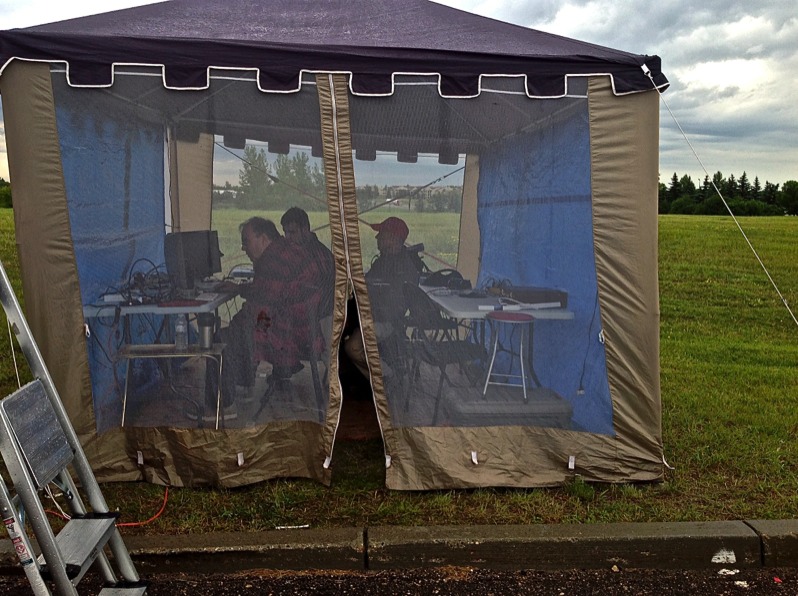
.
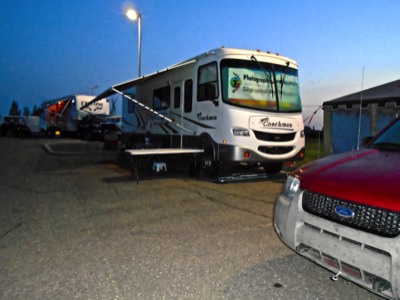
Using the motorhome generator was not a workable solution, it was noisy and made it hard to work in the screen tent from the exhaust fumes. So on Sunday, the day of the opening and the first competitions, we still had no power and no internet. The electrical fix of the day was to switch to using an inverter off the motorhome’s batteries. That worked until I killed the battery at 10:30 PM, then after jump starting it, the Escape became the power supply with the inverter working off it until the wee hours of the morning.
Monday morning came, still no power and no internet and the discovery that of the thirty or so confirmed photographers ,most of them were not only not checking in, but were not likely to even participate.
.
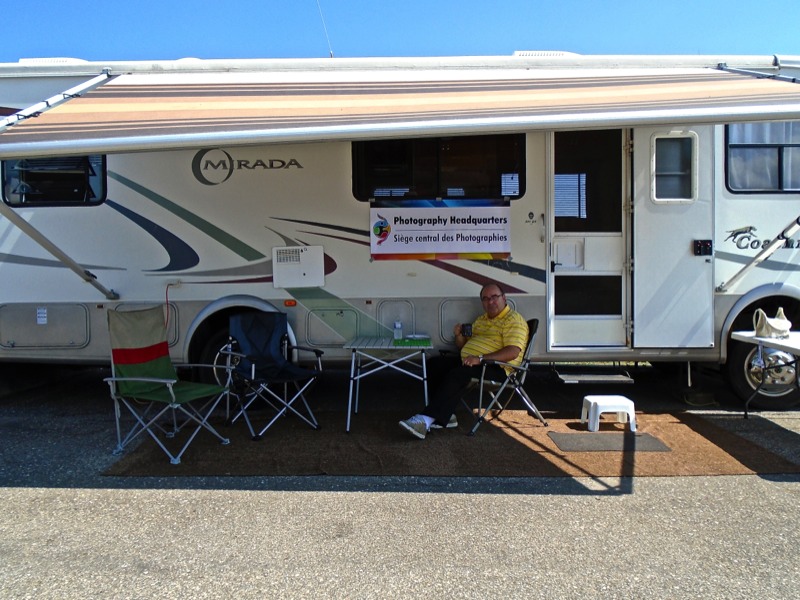
.
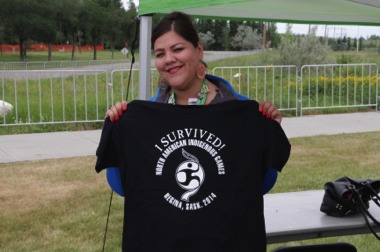
Even before we got to Regina, I had had messages from the volunteer photographers about equipment. The majority were not camera club people, but enthusiastic young first nations people who wanted to participate in the games. Ken and I had not thought about this, it had not crossed our minds that our photographers would not have cameras. Though Ken and I tried, we were unable to get borrowed equipment to the project. Ken made several calls from Halifax to stores in Regina, all without success.
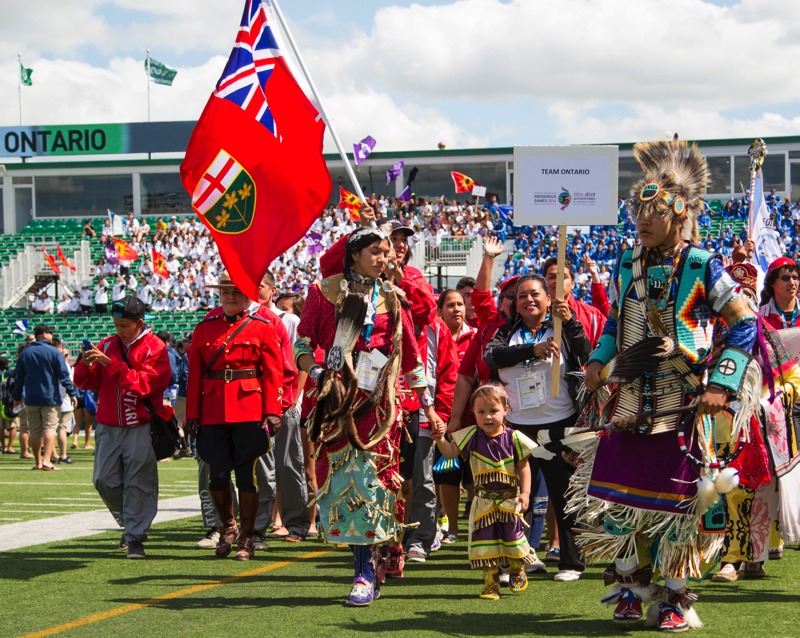
.
However, we did have a core of about ten serious camera owners and they not only were equipped, they were also talented and hard workers. Their work during the week is totally remarkable. Those with cell phones and a few point and shoot cameras, also made a huge contribution as they captured the essence of the games. They captured the feeling and the atmosphere that made this one of the most remarkable week’s in my life. At the end I will tell you more about some of the things I learned.
By the middle of Tuesday night, it was clear I was in trouble. The pictures were pouring in and I was struggling to get the process working in my screen tent office. To make matters a little more complicated, on Sunday evening I passed a camera to my wife through the door of the motorhome and we bobbled it, I lunged to catch it and scrapped a shin on the doorstep. By Wednesday morning It was swollen and clearly infected. I declared an emergency mid morning and headed to see a doctor and asked my son and daughter-in-law to come in that afternoon to deal with the incoming pictures.
By the middle of Tuesday night, it was clear I was in trouble. The pictures were pouring in and I was struggling to get the process working in my screen tent office. To make matters a little more complicated, on Sunday evening I passed a camera to my wife through the door of the motorhome and we bobbled it, I lunged to catch it and scrapped a shin on the doorstep. By Wednesday morning It was swollen and clearly infected. I declared an emergency mid morning and headed to see a doctor and asked my son and daughter-in-law to come in that afternoon to deal with the incoming pictures.
.
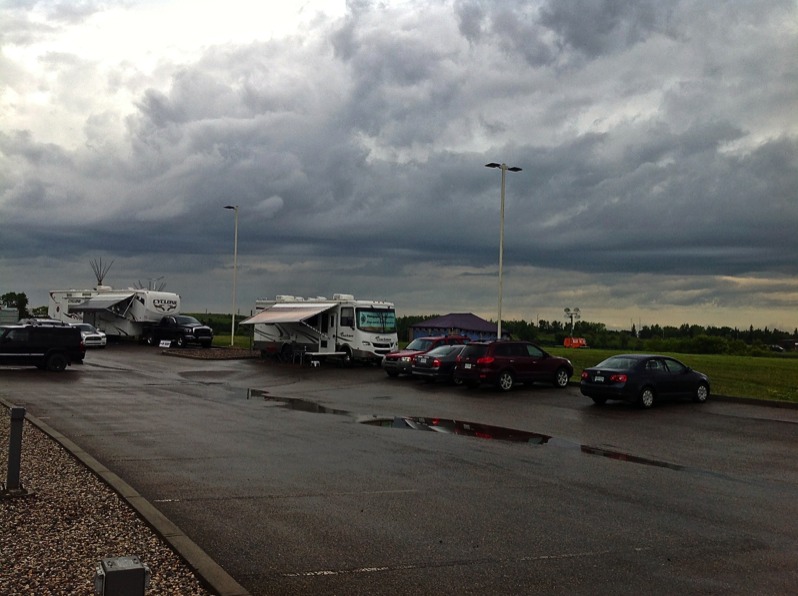
.
After lunch Wednesday, I was back to work, I was taking my medication and the reinforcements arrived and we started to cook the pictures. I was paying close attention to the weather and just before supper we dismantled all five computers and rigged the screen tent for a storm. We set up the computers in the motorhome and just in time the storm hit. The wind and rain were pretty steady then the wind moved to destructive in force and our screen tent was destroyed. Over in the Cultural Village their shelters and tents were damaged and some destroyed but we worked on inside.
.
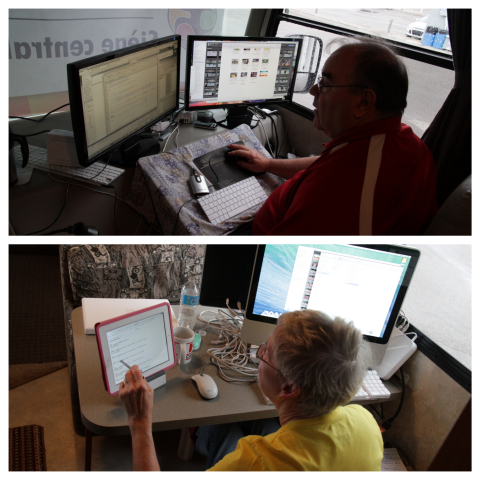
The closing ceremony ended at ten on Saturday night and ten minutes later our electricity was cut off. You would have thought that being two days late getting it turned on would have somehow counted, but it did not and I turned on the motorhomes generator. At 2:00 AM Judy was very upset and rightly so. The motorhome’s carbon monoxide warning device had gone off and that ended work for that night.
I stayed on site Sunday until 6:00 PM waiting for last minute drop offs and then with the Escape in tow left the campus.
.
It took the next two weeks to finish up the pictures. I have still a few videos to post, but the pictures are up and the project concluded on Wednesday of this week.
By the way, Ken Jones did make it back to Regina and was busy shooting pictures Thursday through until Sunday.
A total of 194 albums of pictures were created and posted on the web site. Because many of those pictures were made with smartphones and iPads, many of those pictures really needed a lot of work to be useable. Another time factor was that though I had thought I made it clear to the picture takers, that all pictures were to be shot in landscape mode, I still received about 20% of the pictures in portrait mode. That may not seem like a problem until you realise that computer screens view all pictures in landscape mode, therefore all those portrait pictures had to be cropped, or deleted. Next time, if there ever is a next time, portrait mode images will not be accepted at all.
By the way, Ken Jones did make it back to Regina and was busy shooting pictures Thursday through until Sunday.
A total of 194 albums of pictures were created and posted on the web site. Because many of those pictures were made with smartphones and iPads, many of those pictures really needed a lot of work to be useable. Another time factor was that though I had thought I made it clear to the picture takers, that all pictures were to be shot in landscape mode, I still received about 20% of the pictures in portrait mode. That may not seem like a problem until you realise that computer screens view all pictures in landscape mode, therefore all those portrait pictures had to be cropped, or deleted. Next time, if there ever is a next time, portrait mode images will not be accepted at all.
.
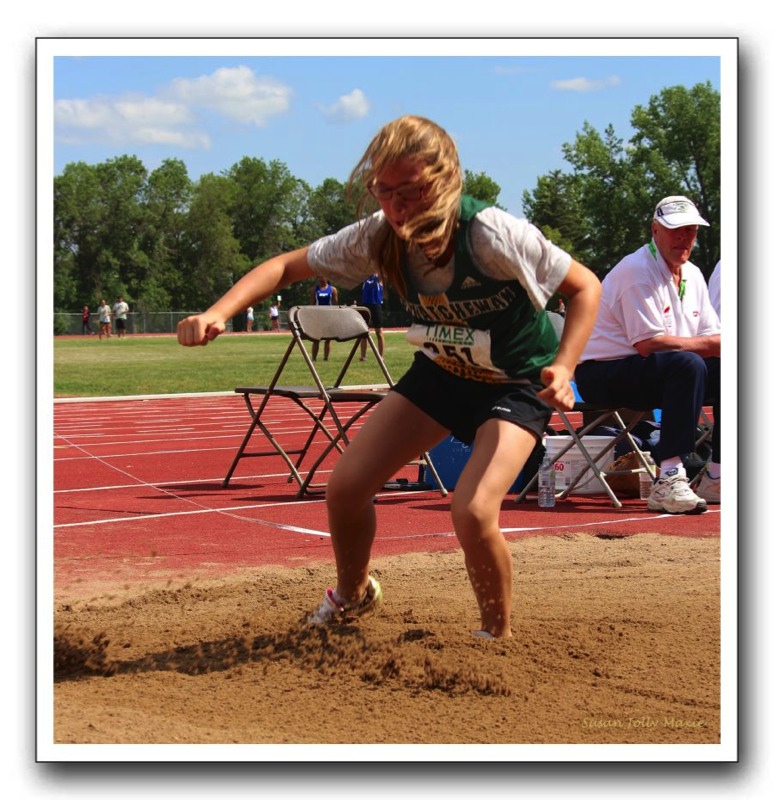
.
So, what did I learn. The most important lesson of all is that the impossible is called the impossible, because it can not be done. In this case, when Ken was not available to do the work with the volunteer photographers, my job became impossible and I had just shrugged and thought I’ll muddle through and it will work out. No, it was impossible. The preparation time to set up the web site, work out the protocols for files, archives, hard drives and network, could not be accomplished if you were still working on the schedule. The second thing I learned and this one is so obvious, I must be the only person not to know this, but the wind in Regina on an average day exceeds the capabilities of a screen tent as an office. But there is more.
Though I have as a person involved in education, been exposed to First Nations people, the North American Indigenous Games showed me, what the people landscape of first nations people is like in 2014 and it is good. Of course I have stereotypes and had expectations before the games and all of them were wrong. Not just individual after individual, but as a whole group of people, I was really fortunate to have this experience. I saw talent, leadership, skills of every kind and a huge capacity to adapt to situations at remarkably short notice. The pessimism that all people in Saskatchewan share, be they status, non status, or European in origin, may have about the progress of Saskatchewan’s first nations people, is unfounded. Together, as people of Saskatchewan, we are going to make it, this is going to be a very good society, because the people exist who will make it a good society and everyone needs to focus on the positive and things will work out.
Though I have as a person involved in education, been exposed to First Nations people, the North American Indigenous Games showed me, what the people landscape of first nations people is like in 2014 and it is good. Of course I have stereotypes and had expectations before the games and all of them were wrong. Not just individual after individual, but as a whole group of people, I was really fortunate to have this experience. I saw talent, leadership, skills of every kind and a huge capacity to adapt to situations at remarkably short notice. The pessimism that all people in Saskatchewan share, be they status, non status, or European in origin, may have about the progress of Saskatchewan’s first nations people, is unfounded. Together, as people of Saskatchewan, we are going to make it, this is going to be a very good society, because the people exist who will make it a good society and everyone needs to focus on the positive and things will work out.
.
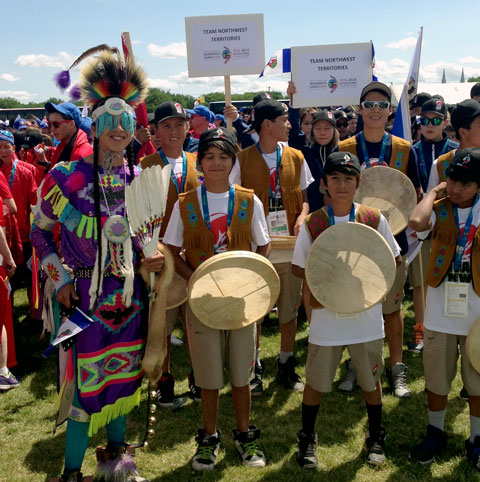
.
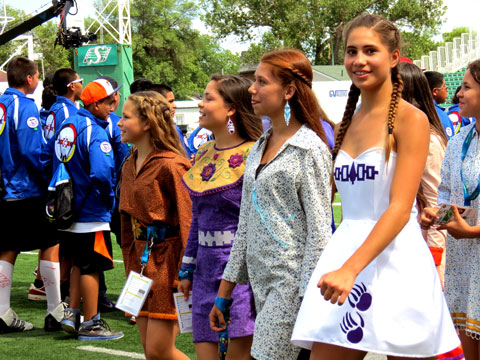
.
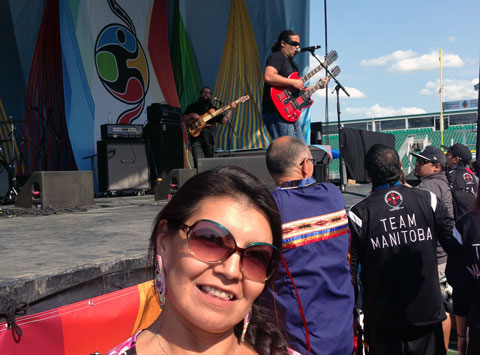
One of our photographers had a sad thing happen to him at the opening ceremony. He was using two cameras. A digital single reflex lens camera and a single reflex lens film camera. He was the only photographer to shot film this year. In 2005 we had perhaps eight or ten people shooting film. He was in the right spot, he had the action all about him and he got his pictures. Check out “Barry Munro’s” albums on Sunday, July 20. His best shots, you will never see. He took his film to be processed, the ageing worn out film process failed mid way through his roll of film and destroyed those images. Another photographer shooting the opening was using a fairly complex camera and he is an experienced user of the camera, but in this case, it turned on him and created a bunch of exposure problems. Afterward, he reset the camera to factory setting and the problem went away. A third photographer with an absolutely fabulous camera and lens, who on every shoot was in position, had some odd exposure issues that one would never have thought of, his expensive lens and expensive camera were not compatible with each other.
.
Meanwhile, the smartphone and iPad shooters also had their problems. These kinds of cameras have wide angle lens and work really well for about three metres, after that, not so good. The other problem they have is pretty obvious, but when you are at an event trying to capture the moment, you might not check, they easily develop a dirty lens. Since they are in a pocket, or your hand, precious images can be ruined by a smudge on that tiny lens that you may not even be sure of where it is on the back of the device.
I learned much more and will continue to discover things that happened in that whirlwind of a week. I was asked if I would do it again? The answer is that I would make the decision in a heartbeat, absolutely. The photographers did the work, they got out and saw things and lived through those competitions, but I got to savour all of it, and it was good.
Here is a list of the heroes of this project. The photographers who went out and got the pictures: Charlene Alexson, Kathy Bechard, Gary Barbero, Gail Chin, Helene Cote, Jarett Crowe, Rochelle Daniels, Cherish Deegan, Larry Easton, Glidas Helye, Beverly Jay, Susan Jolly-Maxie, Ken Jones, Ram Kafley, Bishna Kafley, Crystal Kaye, Sarah Keeshane, Nicole Lerat, Amber Maxie, Joanne Mortensen, Erik Mortensen, Barry Munro, Chrystal Pelletier, Cicely Poitras, Gail Rockthunder, Janelle Salm, Sharlaine Starblanket, Jamie Stephenson, Sirjana Subedi, Harwood Truscott and Stephanie Wilkinson.
I learned much more and will continue to discover things that happened in that whirlwind of a week. I was asked if I would do it again? The answer is that I would make the decision in a heartbeat, absolutely. The photographers did the work, they got out and saw things and lived through those competitions, but I got to savour all of it, and it was good.
Here is a list of the heroes of this project. The photographers who went out and got the pictures: Charlene Alexson, Kathy Bechard, Gary Barbero, Gail Chin, Helene Cote, Jarett Crowe, Rochelle Daniels, Cherish Deegan, Larry Easton, Glidas Helye, Beverly Jay, Susan Jolly-Maxie, Ken Jones, Ram Kafley, Bishna Kafley, Crystal Kaye, Sarah Keeshane, Nicole Lerat, Amber Maxie, Joanne Mortensen, Erik Mortensen, Barry Munro, Chrystal Pelletier, Cicely Poitras, Gail Rockthunder, Janelle Salm, Sharlaine Starblanket, Jamie Stephenson, Sirjana Subedi, Harwood Truscott and Stephanie Wilkinson.
.
.
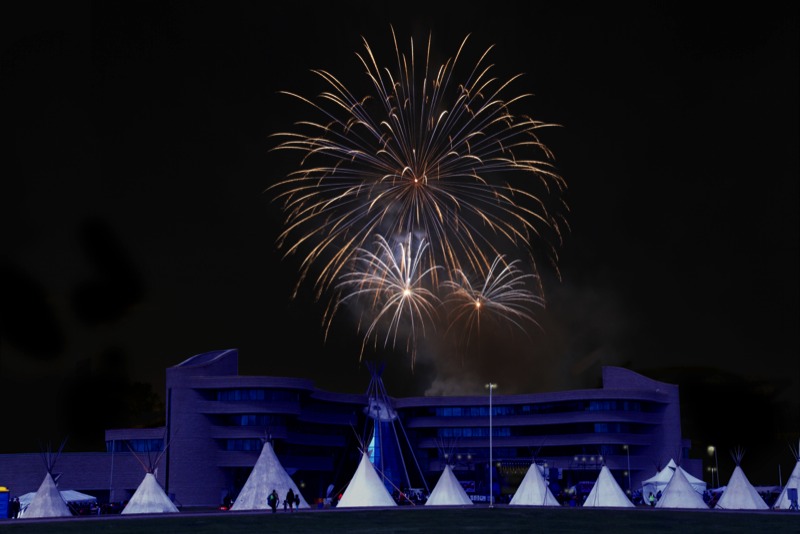
.